You might think you’re ready for Versailles, but you could be wrong. The Estate of Versailles is VAST and, while I’m about to walk you through how to do it in one day without losing your mind, it’s best to give it more than a single visit.
The first thing you need to know about Versailles is that it’s going to be crowded. Really, truly, god-awful crowded. Imagine being in the most beautiful, opulent place in the world. You’re surrounded by mirrors and gilding and porcelain, everything shimmers and sparkles. Now… imagine being in that place, but half the population of the entire world is there with you. You know there are beautiful things in the rooms, but you can’t see them and – wait – did someone just smack you in the head with their selfie stick? They did. Everybody is too close to you and everybody smells because they’ve been standing in a queue in the sun for three hours and everybody’s stupid kids are screaming about wanting a snack and…..
Get the picture?
Now here’s the good news: I can tell you how to get around ALL OF THIS. Why? Because I love you. And also because I’m like some kind of museum ninja.
But first… let me introduce you to Versailles, because I’m not just your run-of-the-mill blogger who’s going to start by telling you how to get there from Paris (I’ll do that too though).
I’m a historian, and this is my blog so I do what I want. I love stories and I love characters, and by god does Versailles have a lot of both. And, despite everything I’ve said about the crowds, Versailles is charming and sexy and a thousand percent worth your time.
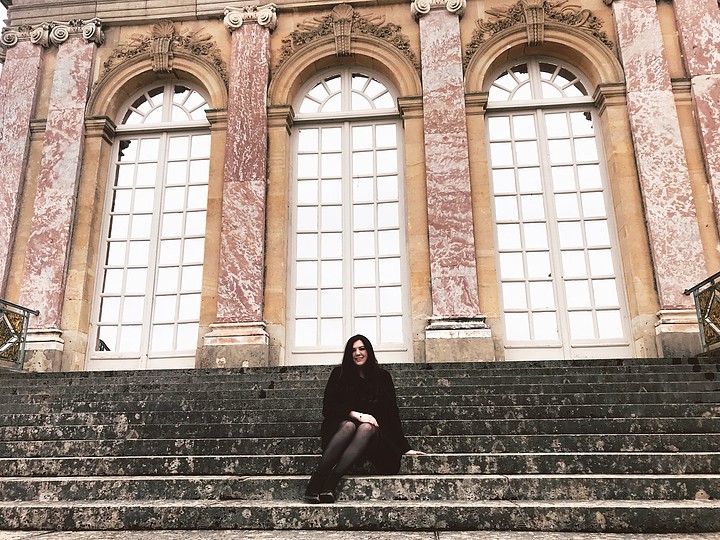
The History of Versailles
Sidenote: I am not a French historian.
It’d be impossible to tell the entire story of Versailles in a few pages worth of text, but I love a challenge. Versailles had a humble beginning as a medium-sized two-story hunting lodge belonging to the King of France, Louis XIII. But forget him, because our story begins with his son – Louis XIV (henceforth referred to as Louis because that’s easier). Louis became King of France at 4 years old, which might explain why he was a bit of an entitled prick. Louis believed in ‘absolute monarchy’, which basically meant that he was in charge of literally everything and that his word was the law. So, when Louis decided that the perfectly lovely and gargantuan French Royal Palace of Fontainebleu wasn’t good enough anymore and that he wanted a new palace built, nobody blinked an eye.
Louis decided he wanted his new palace to be built as a giant fuck-off extension of his father’s hunting lodge in Versailles, which was surrounded by thousands of acres of prime….. swampland. Mere nature, however, was nothing in the face of the man who referred to himself as the ‘Sun King’ – anyone else getting tiny dick syndrome vibes? Louis’ landscape architects and gardeners were forced to drain hundreds of acres of swamps and move entire forests to clear the land and make way for what would eventually be the gardens of Versailles.
And then there was the chateau itself…
Louis’ palace was built in phases, beginning in 1661. Wing by wing, extension by extension, Louis’ architects spent over 50 years creating the bulk of what visitors see today. One of the chateau’s crowning glories is the Hall of Mirrors, a 73 metre long hall full of, you guessed it, mirrors. Mirror glass was one of the most expensive things you could buy at the time, so naturally Louis wanted shit tons of it to flaunt his wealth.
Despite all of this, Versailles wasn’t just a vanity project – it was a way of life, and it was a very clever power play. Because the King was now in Versailles, the entirety of French nobility moved there as well in order to be around Louis and gain his favour. This gave Louis more control over the aristocracy, and by god did he love control.
Everything at Versailles revolved around status and ceremony. People have literally written books on how complicated this shit was, but I’m just going to talk to you briefly about my favourite aspect – the levée. Every morning when Louis woke up, he would have a getting-ready ceremony that involved up to 100 people – basically the most epic glam squad imaginable. All of the most important courtiers each played a part. Your rank determined your role in this ceremony, which could include things as exciting as handing the King his razor or putting on his undershirt.
At the end of the day the same thing would happen all over again, in reverse.
Shit gets a bit complicated when our OG Louis dies in 1715. You see, four years before – in 1711 – his son and heir had died. The next tragedy happened less than a year later, in what I can only describe as some kind of god-awful gypsy curse on the family, when Louis’ grandson also died. Choo choo bitches because the death train doesn’t stop there… just a few weeks after his grandson passed away, Louis’ eldest great-grandson died. What the actual fuck.
Luckily, there was another great-grandson knocking around, and his name was also Louis. He became Louis XV and I will henceforth refer to him as New Louis.
New Louis’ two most favourite things were wars and whores, and man did he have a lot of both. His two most famous mistresses were Madame de Pompadour and Madame du Barry, both of whom deserve their own posts, but this mini-history is getting a bit too lengthy. Are you still with me? Good. What you need to know about New Louis is that he drained the country’s coffers buying super OTT lavish gifts for his mistresses and waging expensive wars, most of which ended up being disasters. In conclusion, New Louis basically set the stage for the French Revolution and downfall of the entire French Monarchy. He totally balls-ed up his job. And then he died, leaving the mess with his heir.
Remember that gypsy curse? It’s back. New Louis’ son and heir died while he was still alive and ruining the country, but thankfully he had a grandson to inherit the throne and his great big mess. So, upon his death in 1774, New Louis’ grandson takes the throne as Louis XVI… and he will henceforth be referred to in this post, tragically, as Last Louis.
When he was 15 Last Louis married the Austrian archduchess Maria Antonia, who you’ll probably know as Marie Antoinette. The marriage didn’t start well. For starters, the French hated Austria. In the years leading up to the marriage, the two countries had been enemies, so Louis and Marie’s marriage was arranged in hopes of forging an alliance. And then there were the wedding celebrations… To allow the citizens of France to share in their joy, the monarchy held a series of balls and spectacles in Paris following the wedding nuptials. A huge display of fireworks on the Place de la Concorde attracted enormous crowds, but ended in tragedy went a fire broke out which is said to have killed over 600 people. Not a great start. To make matters worse, the new royal couple weren’t shagging – which was basically their only job. According to some sources, they didn’t do the deed for seven years. I’d love to speculate about this for ages, but I’m running out of time.
The good news is that Marie Antoinette and Last Louis did finally figure out how to bone. The bad news is that they did it just in time to have children who would be terrorised by the French Revolution.
Yep, Vive La France – wave your Tricolore around because THE revolution is here. A myriad of events can be attributed to the lead-up to the revolution, including an absolute shit-storm whodunit drama called the ‘Affair of the Diamond Necklace’ which is worth a Google, but let’s just suffice by saying that by 1790 the people of France had really started to hate the monarchy. Part of this was absolutely propaganda and lies because everybody needs a scapegoat for their problems, and part of it was the Crown’s reluctance to make any kind of political reforms in a time of great debt and crisis. Whichever side you decide you’d like to take though, the end result is that the French monarchy was doomed. The royal family attempted to escape, but were arrested and brought to Paris.
Between summer 1791 and Autumn 1792, the royal family were essentially put under house arrest and every effort was made to reduce their power. During this time some of the royal couple’s closest friends and confidants were convicted and beheaded, and in September 1792 the monarchy was officially declared non-royal by the French Republic. Now mere citizens, the royal family could be tried for crimes against the people. In January 1793, the former King (our Last Louis) was tried, convicted, and beheaded. In the aftermath of his death, Marie Antoinette was separated from her children. Her son, who would have been heir to the throne, was coerced into accusing her of multiple crimes – including incest with him. In October of 1793 Marie Antoinette was tried for various crimes, having been made out to be both a foreign spy and a slut. Her and her lawyers were given less than a day to prepare, and she was convicted of high treason and beheaded less than two days after she found out the trial would even take place.
I feel compelled to say that the story of the French Revolution, and indeed of the French Monarchy, doesn’t end with Marie Antoinette and Last Louis. Sadly (or happily, if you’re tired of reading) my story about Versailles does. The palace and its grounds are still a testament to the extreme amount of power and wealth the French monarchy held prior to the revolution, and it feels fitting to end my history with the end of two of the palace’s most famous residents, sad as it all may be. If you have any burning questions about French history after reading this, please ask someone more qualified. Now, time for the logistics…
To pre-book or not to pre-book?
First things first – unless you’re an international celebrity you’re going to end up queuing at Versailles no matter how you decide to purchase your tickets. I’m the proud owner of a magical ‘International Council of Museums’ card which gives me free access to pretty much every museum and historical site in the world for free. I’ve skipped queues and been taken in through back entrances like a Queen at nearly every major museum and site in the world – Pompeii, The Hermitage, The Louvre, etc…. but NOT at Versailles. The hitch here is that everybody goes through the same security queue at the gates, regardless of your ticket type, which means a monumental wait is inevitable. Here are your options, from best to worst (IMO):
Pre-book through the official website: You won’t be able to skip the security queue, but you will be able to skip the line-buying queue… which helps. There are timed tickets available on the website which promise entry within 30 mins of your selected time, but be warned that this selected time is for the palace only, so you’ll have to visit the palace at a very specific time slot which is actually more of a hassle than anything – especially if the palace ends up being packed at that time (early in the day is always the worst). Instead, just buy a normal ‘passport’ which includes un-timed entry to everything on the grounds and allows you to explore at your leisure rather than to a schedule.
Buy the Paris Pass: I have never been a fan of city passes – mainly because there’s usually no fucking way a tourist spending 24-48 hours in any city will make use of them enough to save money. They make you stick out like a big fat tourist waving your fat neon tourist flag, and you’re usually better off pre-booking visits for a few select museums and enjoying yourself rather than trying to take on the impossible task of visiting every single historical site in a metropolis in order to ‘get a bargain’. If you already have a Paris Pass, that’s fine – but it won’t do you any good at Versailles. The ‘skip the line’ feature only works at sites in Central Paris, so be prepared to wait.
Buy your tickets at Versailles: A truly horrible idea, especially if you’re visiting in the summer. You’ll be forced to wait in the both the security queue as well as the god-awful ticket office queue. Don’t say I didn’t warn you…
Getting to Versailles from Paris
Getting to Versailles from Paris is a breeze due to the city’s vast public transport system. In Paris, there is the Metro (which covers the city) and the RER trains (which cover the suburbs of Paris). The RER lines are labelled from A-E and Versailles is on the C line, which is yellow on the map. There are stops on the C line near Notre-Dome, the Musee d’Orsay, the Eiffel Tower, etc, as seen below.

All you need to do is go to any of these stations and buy a ticket for Versailles. Versailles has two stops, and you’ll want to buy the one for Chateau/Rive-Gauche. I highly recommend buying your return ticket while you’re at it, as the queues at Versailles station coming back can be hellish.
From there, just hop on the train. It’s hard to mess anything up or go in the wrong direction as there are signs everywhere. It usually takes about an hour to get to Versailles, depending on which station you board from, so sit back and relax.
How to beat the crowds once you’ve arrived
The best way to do Versailles is ass backwards. You’ll enter through the famed golden gates, but once you’ve gone through security don’t stop at the palace – even for a few photos. Walk away, keep walking away, and walk all the way away until you reach the Trianon Estate. The easiest way to do this is to head straight for the Grand Canal and turn right when you hit its cross (handy map below), but the prettiest way to do this is zig-zagging through the gardens. There are signs literally EVERYWHERE so don’t worry about getting lost.

The Trianon Estate is home to the Petit Trianon and the Grand Trianon, and at the beginning of the day they are both usually EMPTY of tourists. Enjoy it while it lasts.
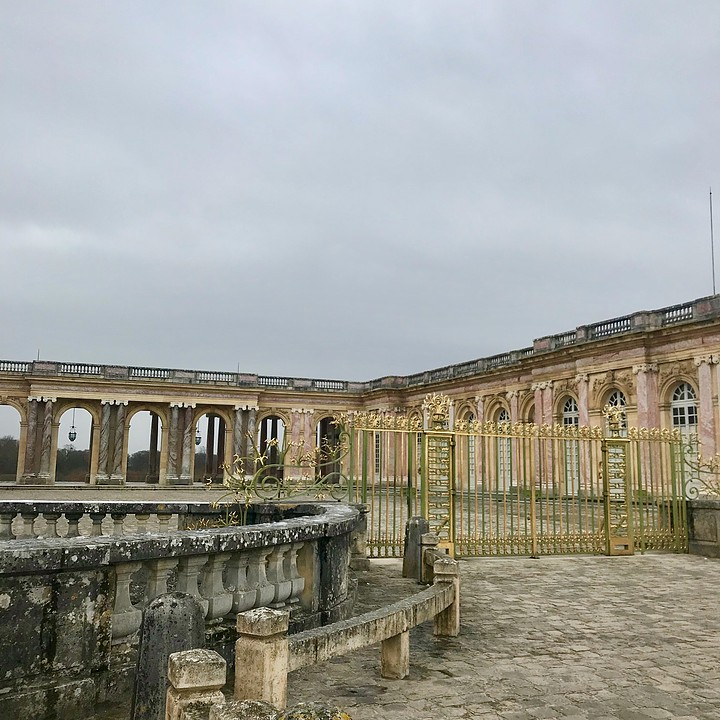
You’ll visit the Grand Trianon first. This was built by the OG Louis (Sun King, tiny dick syndrome Louis) as a retreat for him and his chief mistress. Here they could escape the rigid court life that, ironically, he had invented. After his death it became an important residence for various high-ranking members of the royal family and French aristocracy.
A short stroll away is the Petit Trianon, which was built for the mistresses of New Louis (Last Louis’ grandfather, if you’ve forgotten). The moral of the story here is if you want a mini palace, shag a French King. Eventually, the Petit Trianon and surrounding land was given to Marie Antoinette by her husband – Last Louis. In this part of the Estate, Marie Antoinette’s word was law – not her husbands. Nobody was permitted entry without her approval, and she enjoyed plenty of time here away from court.
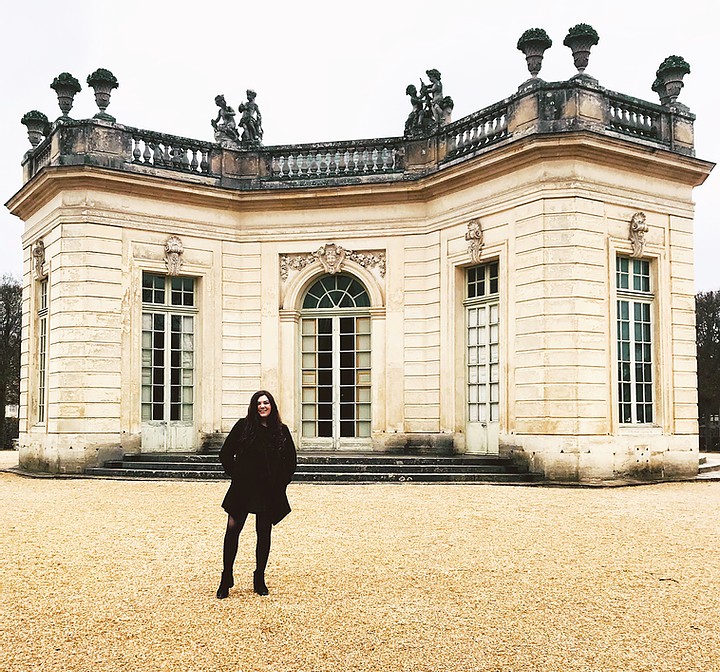
The final part of the Trianon Estate is the Hameau de la Reine, which you cannot miss. The hameau, French for hamlet, is an entire faux village Marie Antoinette had created so that she could play farmer’s wife. There’s a watermill, a dairy, barns, and various cottages, with little kitchen gardens smattered in between. Here, Marie Antoinette could dress up like a dairymaid (I’m dying) and enjoy the simple life with her best mates.
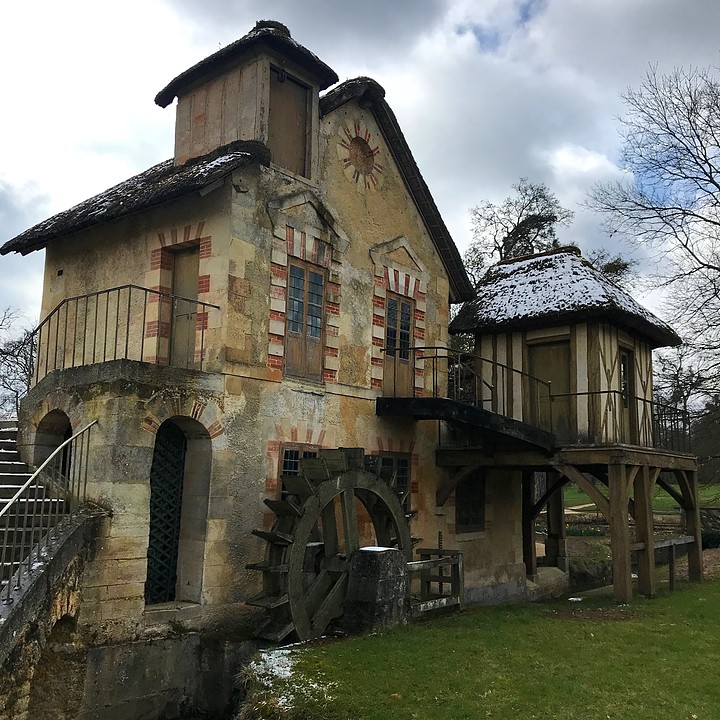
I should cut her a bit of slack though, partly because I’d absolutely do the same exact thing and partly because the hameau was, for the most part, a functioning farm which produced eggs, dairy, and various crops. You can stroll around the hameau today, and it’s as delightful an escape from the chateau now as it was for Marie Antoinette hundreds of years ago. There are tons of animals, including the cutest ever spotted baby donkey.
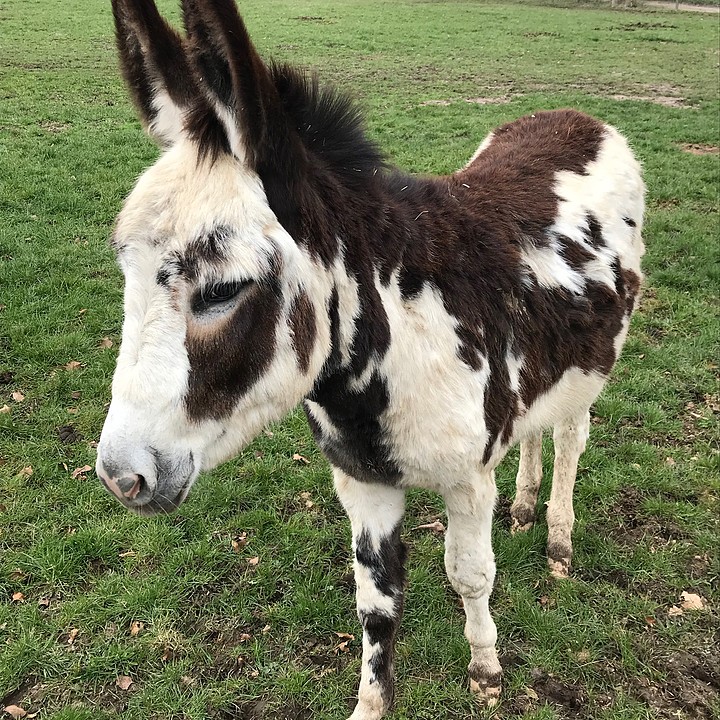
Lunch
After playing farmer, you might be feeling a bit peckish. There are plenty of places to grab lunch in Versailles, but my favourite is La Flottille which is located at the top end of the Grand Canal, the part closes to the Chateau. It’s quaint, reasonably priced by Versailles standards, and the service is always spot on. I love the buckwheat galette (like a crepe – but savoury) filled with goats cheese, walnuts, and honey. They also do decent pizzas… but come on, you’re in France. If the weather is behaving itself, they’ve got a gorgeous seating area outside that’s perfect for downing a glass of champagne and people watching while you rest your feet from exploring the Estate.
The Gardens
They’re famous for a reason. You’ll have seen some of the gardens on your walk to the Trianon Estate, but it’s worth exploring them a bit more if you have the time and energy. There’s no rush to get to the Chateau until the late afternoon as it’ll still be heaving with people, so relax and enjoy strolling through the manicured parterres and stumbling upon ornate fountains… all the while remembering that this entire estate used to be a swamp.
The Chateau
After what has hopefully been a peaceful day, it’s time to visit the Chateau itself. I recommend heading in about 60-90 mins before close, as the vast majority of the crowds will have left by then. It’ll still be a bit busy, yes, but you’ll be able to breathe, move your arms and legs without them brushing against strangers, and actually see things in the room you’re in besides the ceiling. There’s a set route inside the house, so you don’t need my guidance.
Enjoy the opulence.
It seems like it would have been a great place to live, but I love spoiling things for people so I feel compelled to tell you that the Chateau smelled like fresh hell in its prime. Apparently there weren’t enough loos, a problem they still have today. Chamber pots had to either be carried, stinking, through the public halls of the Chateau, or simply tipped out the window into the formal gardens. Pipes which were eventually put in to manage the mass amounts of human waste often got blocked up and overflowed, sometimes overflowing into the kitchens – lovely. Because finding a toilet was sometimes a pain, some of the courtiers would simply pee whilst walking through the halls, and we know that the King had the Chateau floors cleansed of shit and piss on a weekly basis. If you think opening the windows to let in a fresh breeze might have solved the problem, think again. The swampy grounds and large bodies of stagnant water (canals, fountains, ponds) meant it smelt like ass outside as well. What a dream.
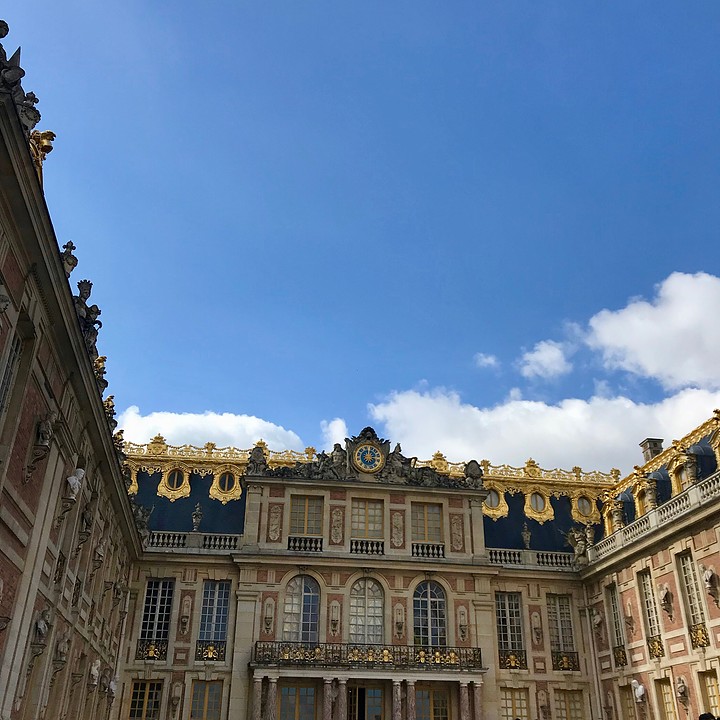
I should probably close this on a nice note after all of that, but I’m out of nice facts about Versailles. Plus, if it is crowded when you visit – at least now you can be pleased that nobody is peeing next to you in the hallway. You’re welcome.
I hope you’ve enjoyed this whistle-stop tour of an Estate you should really be spending at least 48 hours on. If you’ve been to Versailles and have any secrets or tips of your own, I’d love to hear them – leave a comment below!
Au revoir, peasants.
xx Courtney
